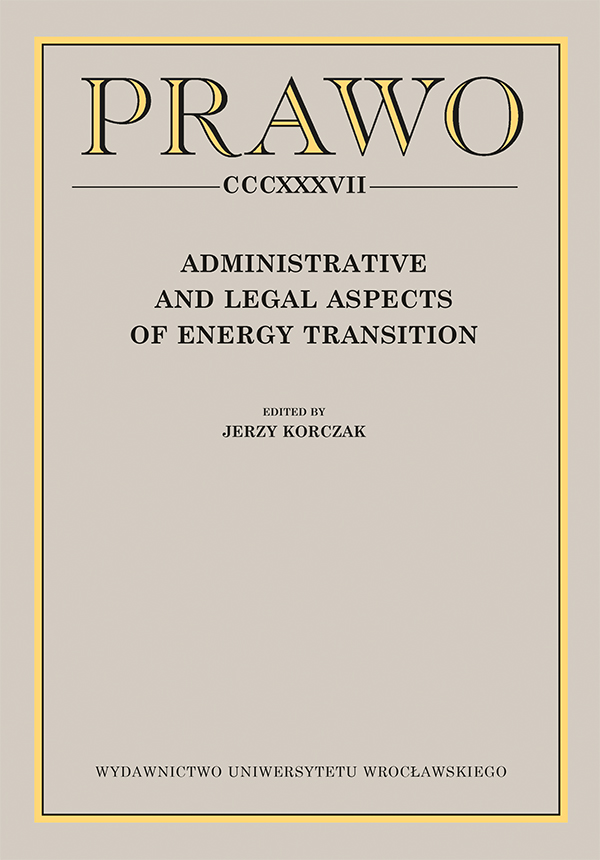

Articles

This paper discusses various aspects of the development of low-emission public transport as the implementation of the electromobility policy. Fossil fuels, the primary source of energy for the transport sector, are harmful to the environment. Ecological transport solutions, such as electric vehicles, bicycles and public transport powered by renewable energy sources, offer a cleaner, more sustainable alternative. The transition from fossil fuels to ecological transport solutions will require significant investment in infrastructure, research and development and public education, but the benefits far outweigh the costs. The topic of electromobility is crucial for environmentally friendly transport. This paper presents philosophical, strategic and legal aspects of electromobility.
Directive 2014/94/EU of the European Parliament and of the Council of 22 October 2014 on the deployment of alternative fuels infrastructure , Official Journal of the European Union L 307, 28 October 2014, 1.
Act on Electromobility and Alternative Fuels of 11 January 2018, Journal of Laws 2018, item 317.
Resolution No. 8 of the Council of Ministers of 14 February 2017 on the adoption of Strategy for Responsible Development to 2020 (with a perspective to 2030), Monitor Polski of 2017, item 260.
Resolution No. 109 of the Council of Ministers of 24 September 2019 on the adoption of Sustainable Transport Development Strategy until 2030, Monitor Polski of 2017, item 1054.
Communication from the European Commission EUROPE 2020. A strategy for smart, sustainable and inclusive growth, Brussels 2010, COM (2010) 2020 final
Plan Rozwoju Elektromobilności w Polsce “Energia do przyszłości”, https://www.gov.pl/attachment/7cbc60f4-fec6-4dc1-b950-548cb0e52e9e
Bachanek K., “Electromobility in public transport – good practices and experiences of cities in Poland,” Economics and Organization of Logistics 1, 2020, no. 5, pp. 79–93.
Biuletyn Informacyjny CUPT no. 3/2022.
Chandler Jr. A.D., Strategy and Structure, Mckeesport, Pennsylvania 1962.
Electromobility in Poland, Investments, Trends, Employment, 2021 report, Polish Investment and Trade Agency.
Fundusze Europejskie na Infrastrukturę, Klimat, Środowisko 2021–2027.
Peek J., “Thomas Edison, a man ahead of his time, built his own electric car in 1912,” Hagerty, https://www.hagerty.com/media/automotive-history/thomas-edison-a-man-ahead-of-his-time-built-his-own-electric-car-in-1912.
Połom M., Wiśniewski P., “Implementing Electromobility in Public Transport in Poland in 1990–2020. A Review of Experiences and Evaluation of the Current Development Directions,” Sustainability, 2021, no. 13, pp. 1–23.
Połom M., “Diversification of policies for the development of electric public transport in the Czech Republic, Poland and Slovakia,” Prace Komisji Geografii Komunikacji PTG 4, 2022, no. 25, pp. 59–73.
Program operacyjny infrastruktura i środowisko na lata 2014–2020, Ministerstwo Funduszy i Polityki Regionalnej, https://www.pois.gov.pl/media/110770/Poiis_v_24_0.docx
Taczanowski J., Kołoś A., Gwosdz. K., Domański B., Guzik R., “The development of low-emission public urban transport in Poland,” Bulletin of Geography. Socio-economic Series, 2018, no. 41, pp. 79–92.
Wlaźlak k., Racjonalność planowania w prawie administracyjnym, Warszawa 2015.
Wojcieszak J, “Rozwój komunikacji tramwajowej w Polsce Poland,” TTS Technika Transportu Szynowego 20, 2013, no. 7–8, p. 8–34.